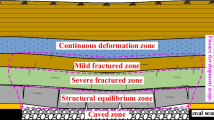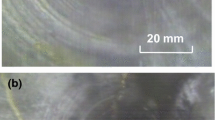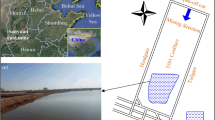Abstract
In underground coal mining regions with damaged overlying strata, under the combined effects of long-term water-rock interactions (WRIs) and mining-induced stress, the permeability of water-conducting fractures (WCFs) decreases significantly due to the self-healing of fractures. Such self-healing helps to reduce the range of fractured water-conducting zone in the overlying strata and prevents the loss of groundwater. Understanding the self-healing mechanism is therefore of great significance for the scientific evaluation of mining damage to aquifers and their self-restoration capacity. It was found, according to the WRI experiments, that the self-healing mechanism involves the following three physical and chemical processes: (1) the sealing of fractures due to the swelling of hydrophilic clay minerals and subsequent blockage of the fracture space due to the argillisation and slaking of clay minerals; (2) the dissolution and corrosion of fracture surfaces due to the flow of groundwater, which leads to reduced surface roughness in the fractures, thereby allowing the fracture walls to seal more closely under the action of mining-induced stress; and (3) ion exchange between the anions and cations present in groundwater and in the rock minerals, including aluminosilicates or carbonates, which leads to the production of secondary minerals or crystalline precipitates that eventually fill or block the fractures. The long-term cumulative effect of the compaction and blockage of WCFs is that their permeability gradually decreases, thereby demonstrating the self-healing mechanism. The results can provide a theoretical reference for water preservation and ecological management of the water-deficient mining areas in northwest China.











Similar content being viewed by others
References
Bilinski A, Lojas J (1983) Practice on slice mining of thick coal seam under artificial cemented roof. J Hunan Univ Sci Tech 1(1):100–108
Chen Y, Cao P, Mao DW, Pu CZ, Fan X (2014) Morphological analysis of sheared rock with water–rock interaction effect. Int J Rock Mech Min Sci 70:264–272
Espinoza DN, Jung H, Major JR, Sun Z, Ramos MJ, Eichhubl P, Balhoff MT, Choens RC, Dewers TA (2018) CO2 charged brines changed rock strength and stiffness at crystal geyser, Utah: implications for leaking subsurface CO2 storage reservoirs. Int J Greenh Gas Control 73:16–28
Fu JX, Shang J, Zhao YH (2011) Simultaneous removal of iron, manganese and ammonia from groundwater in single biofilter layer using BAF. Adv Mater Res 183:442–446
Holla L, Buizen M (1991) The ground movement, strata fracturing and changes in permeability due to deep longwall mining. Int J Rock Mech Min Sci Geomech Abstr 28:207–217
Huang WP, Li C, Zhang LW, Yuan Q, Zheng YS, Liu Y (2018) In situ identification of water-permeable fractured zone in overlying composite strata. Int J Rock Mech Min Sci 105:85–97
Kampman N, Bickle MJ, Maskell A, Chapman HJ, Evans JP, Purser G, Zhou Z, Schaller MF, Gattacceca JC, Bertier P, Chen F, Turchyn AV, Assayag N, Rochelle C, Ballentine CJ, Busch A (2014) Drilling and sampling a natural CO2 reservoir: implications for fluid flow and CO2–fluid–rock reactions during CO2 migration through the overburden. Chem Geol 369:51–82
Kaszuba J, Yardley B, Andreani M (2013) Experimental perspectives of mineral dissolution and precipitation due to carbon dioxide–water–rock interactions. Rev Mineral Geochem 77:153–188
Li SW, Gao MZ, Yang XJ, Zhang R, Li R, Zhang ZP, Li G, Zhang ZT, Xie J (2018) Numerical simulation of spatial distributions of mining-induced stress and fracture fields for three coal mining layouts. J Rock Mech Geotech Eng 10:907–913
Miao XX, Cui XM, Wang JA, Xu JL (2011) The height of fractured water-conducting zone in undermined rock strata. Eng Geol 120:32–39
Monaghan PH, Salathiel RA, Morgan BE (1959) Laboratory studies of formation damage in sands containing clays. SPE Drill Complet 216(12):209–215
Morán-Ramírez J, Ledesma-Ruiz R, Mahlknecht J, Ramos-Leal JA (2016) Rock-water interactions and pollution processes in the volcanic aquifer system of Guadalajara, Mexico, using inverse geochemical modeling. Appl Geochem 68:79–94
Négrel P, Pauwels H, Chabauxb F (2018) Characterizing multiple water-rock interactions in the critical zone through Sr-isotope tracing of surface and groundwater. Appl Geochem 93:102–112
Ning JG, Liu XS, Tan YL, Wang J, Zhang M, Zhang LS (2015) Water-preserved mining evaluation in shallow seam with sandy mudstone roof. J Min Safety Eng 32(5):814–820
Peng WB (1997) Experiment and research for consolidating the roof of high seam with water injection. J Xi’an Min Inst 17(2):121–125
Phana TT, Vankeurena ANP, Hakala JA (2018) Role of water−rock interaction in the geochemical evolution of Marcellus shale produced waters. Int J Coal Geol 191:95–111
Xu JL (2011) Green mining in coal mines. China University of Mining and Technology, Xuzhou
Zhang ST, Liu Y (2012) A simple and efficient way to detect the mining induced water-conducting fractured zone in overlying strata. Energy Procedia 16:70–75
Zhang Z, Zhang R, Xie H, Gao M, Xie J (2016) Mining-induced coal permeability change under different mining layouts. Rock Mech Rock Eng 49:3753–3768
Zhao HS (1992) Research on the mechanism of roof regeneration and related parameters. Ground Pressure and Strata Control 9(2):30–33
Acknowledgements
Financial support from the National Nature Science Foundation of China (51604259) and State Key Research Development Program of China (2016YFC0501104) is greatly appreciated.
Author information
Authors and Affiliations
Corresponding author
Rights and permissions
About this article
Cite this article
Ju, J., Li, Q., Xu, J. et al. Self-healing effect of water-conducting fractures due to water-rock interactions in undermined rock strata and its mechanisms. Bull Eng Geol Environ 79, 287–297 (2020). https://doi.org/10.1007/s10064-019-01550-x
Received:
Accepted:
Published:
Issue Date:
DOI: https://doi.org/10.1007/s10064-019-01550-x




